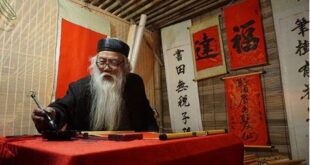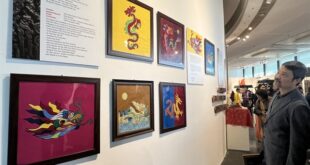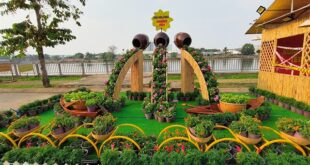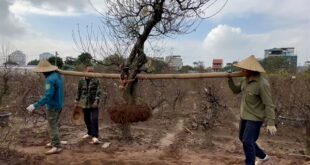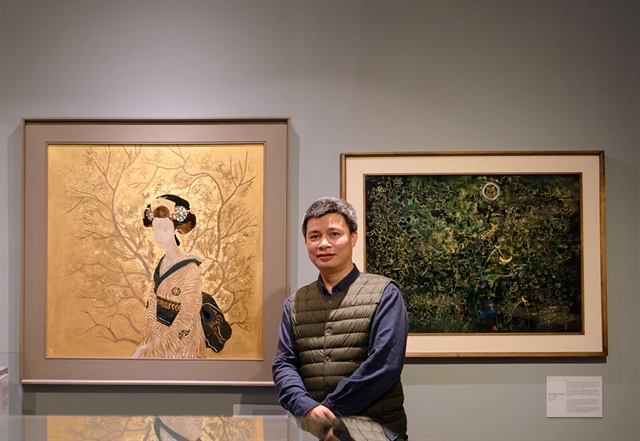
A lacquer painting exhibition entitled Câu Chuyện Phương Đông (The Oriental Tale) by lecturer and artist Triệu Khắc Tiến is going on at Japan Foundation Centre in Hà Nội. Việt Nam News reporter Nguyễn Bình talked with Tiến, Deputy Head of Painting Department at Việt Nam University of Fine Arts, about the exhibition and his lacquer painting research.
You have had exhibitions in Việt Nam and abroad during your career. What are the differences between this and others?
I have participated in many local and international lacquer art exhibitions. However, this is the first time I have held a solo exhibition with the support of the Japan Foundation Centre in Việt Nam. Through the The Oriental Tale exhibition, I have the opportunity to introduce all my research results from my Ph.D. course in urushi art at Tokyo University of the Arts, as well as the latest lacquer artworks.
The Oriental Tale Exhibition is a summary of my creative journey, full of sublime emotions. It is also my reflections of my fortunate opportunity to be immersed in two long-standing lacquer cultures Việt Nam and Japan.
The most special thing in this exhibition is not only introducing to the public my lacquer paintings, but also presenting and introducing the system of Vietnamese lacquer tools and Japanese urushi materials, as well as the system of technical lacquer patterns, as a result of my practice and experimental research during the doctorial course.
What message do you want to convey?
Through the exhibition, I want to spread positive energy to the public, especially young people, the pride of preserving and promoting traditional values in modern times, for which, Vietnamese lacquer painting is an example.
The Oriental Tale exhibition is a cosy space where anyone who visits can find his or her own story, about materials, language, the secret charm of traditional lacquer arts, artistic passion, family, love, and friendship.
By co-operating, sharing experiences with one another, inheriting the traditional heritages of our forefathers, as well as updating the quintessence of human culture, we may build new traditions, starting right away.
In addition, this is also a message I want to convey to my students who belong to lacquer painting major at Việt Nam University of Fine Arts.
I believe that with the efforts of studying professionally, with an open-mind and serious attitude toward art creation, you will be successful on the path to discovering and developing the art of Vietnamese lacquer painting.
You have a Ph.D of Fine Arts at Tokyo University of the Arts. What is the distinction between Vietnamese and Japanese lacquer paintings?
As an essential requirement of the doctorial course was to make comparative research between Vietnamese lacquer painting and Japanese urushi art, and looking for new possibilities of mixing the traditions.
In general, the lacquer materials of the two countries are both derived from natural raw lacquer, and follow traditional lacquer processes like coating layers, drying in a humid room, and grinding.
However, the different physico-chemical characteristics of lacquer trees in each country as well as the distinct aesthetic values lead to different technical systems and methods of expression between Vietnamese lacquer painting and Japanese urushi art.
Urushi is harder than Vietnamese lacquer, so it is difficult to work with either thick layer coating or grinding after covering layers.
However, it is watery enough to cover very thin layers but super sticky, which is highlighted with elaborate and sophisticated techniques like maki-e, chin kin, and kawari-nuri, suitable for art deco trends. Meanwhile, Vietnamese lacquer is softer and very transparent, so we can cover thick layers and grind it easily. This matches the sense of creation which is full of artistic emotion and creative improvisation.
A project developed by the Department of Fine Arts, Photography and Exhibition aims to make lacquer paintings and products become a national trademark. What are your thoughts on this?
I used to participate in this project in the early period, as a lacquer expert. This would be a wonderful thing if the project could be carried out soon.
In the fields of macro-scale management by the government, the project will pave the way for the fundamental re-establishment of the lacquer art context in Việt Nam at present with the precise and official definition of a qualified lacquer product or painting under the national trademark.
Hopefully, this may contribute to the birth of a lacquer museum or institute in the near future.
Furthermore, the project will contribute valuable opportunities for us to integrate with the international lacquer world through professional workshops, seminars, or lacquer art exchange exhibitions.
Many Vietnamese artists currently use imported material not Vietnamese material. Does that affect the traditions of lacquer painting?
Despite the many established techniques in lacquer painting, contemporary artists greatly vary in their methods.
There is a fundamental process to lacquer painting, in mixing colours, building layers, and sanding, but even this is being tested and stretched in definition by young artists, there are many details in stylistic techniques that vary from one artist to the next.
Lacquer painting is an art form that can incorporate many other materials such as gold and silver powder and leaf, eggshells, mother of pearl, bronze powder, etc.
It is in the use of such materials that there are no rules and varying techniques arise to create unique compositions.
Through such various techniques, the uniqueness of the medium is displayed; transparency in colours and texture can be conveyed through lacquer painting, unlike any other.
Additionally, lacquer painting is still a very young fine art form and its mature state has not been reached nor its capacity fully stretched; this is a contemporary development that artists today move towards with a variety of unique techniques.
The fact is that nowadays, many Vietnamese artists use imported material, but not Vietnamese material making lacquer paintings.
From my point of view, this opens an interesting context where lacquer artists have to challenge themselves to find out the possibility of mixing new materials with traditional lacquer ones in a compatible way.
However, this may also lead to a misuse of real lacquer and the wrong concept about Vietnamese lacquer painting when they use other lacquer-like cashew paint or polycite paint (which is imported from Japan) instead of Phú Thọ raw lacquer to do a so-called traditional lacquer painting.
Vietnamese lacquer painting should be done in Vietnamese lacquer. The lacquer extracted from the resin of lacquer tree in the northern province of Phú Thọ offers the best quality, following the three qualified standards of traditional lacquer art: flatness, smoothness, and glossiness.
How did you blend Japanese and Vietnamese lacquer into the paintings at the exhibition?
To me, lacquer is a powerful visual language that always contains unique elements of surprise. It is a combination of the rigorous drawing process with improvisations in the coating-grinding process, and of the abstract and the tangible. It is like an illusion on a mysterious, silver and gold shimmering background.
Based on the knowledge I acquired from the doctorial course in urushi art, I managed to invent a new method of applying Japanese urushi complicated techniques like maki-e, raden, chinkin, etc on the top layers of coating process using Vietnamese refined transparent and black lacquer, while remaining the underneath layers unchanged, following Vietnamese lacquer painting methods, which can be coated with thick lacquer and pigment, offering accidental textural effectiveness after sanding the pictorial surface.
As a result, this combination creates a sensitive balance of aesthetics, between creative improvisation, the liberality of visual painting language, and elaborate details, which are considered highlights of the artwork. VnExpress News
- Reduce Hair Loss with PURA D’OR Gold Label Shampoo
- Castor Oil Has Made a “Huge” Difference With Hair and Brow Growth
- Excessive hair loss in men: Signs of illness that cannot be subjective
- Dịch Vụ SEO Website ở Los Angeles, CA: đưa trang web doanh nghiệp bạn lên top Google
- Nails Salon Sierra Madre
 VnExpress News The News Gateway of Vietnam
VnExpress News The News Gateway of Vietnam
